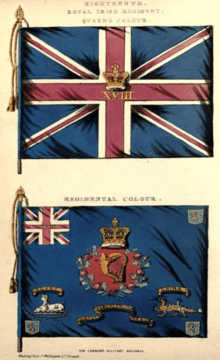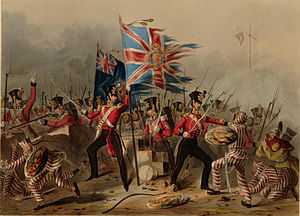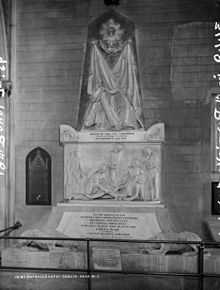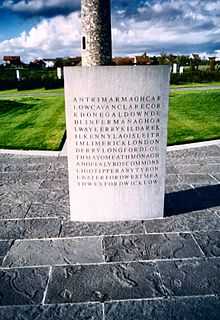Royal Irish Regiment (1684–1922)
| Royal Irish Regiment | |
|---|---|
| Active | 1684–1922 |
| Country |
|
| Branch |
|
| Type | Infantry |
| Role | Line Infantry |
| Size |
2 Regular Battalions |
| Garrison/HQ | Kickham Barracks, Clonmel |
| Nickname | The Namurs, Paddy's Blackguards |
| Motto | Virtutis Namurcensis Praemium (Reward for Valour at Namur) |
| March | Quick: Garry Owen |
The Royal Irish Regiment, until 1881 the 18th Regiment of Foot, was an infantry regiment of the line in the British Army, first raised in 1684. Also known as the 18th (Royal Irish) Regiment of Foot and the 18th (The Royal Irish) Regiment of Foot, it was one of eight Irish regiments raised largely in Ireland, its home depot in Clonmel.[1] It saw service for two and a half centuries before being disbanded with the Partition of Ireland following establishment of the independent Irish Free State in 1922 when the five regiments that had their traditional recruiting grounds in the counties of the new state were disbanded.[2]
Formation

The regiment was formed in 1684 by the Earl of Granard from independent companies in Ireland. In 1695, the regiment became known as the Royal Regiment of Ireland due to its performance at Namur under the direction of King William III. The regiment also won the right to display the King's arms on their colours along with the harp and crown. The regiment served throughout the turn of the 18th century in continental battles before being sent to Gibraltar. In 1751, the regiment was officially ranked as the 18th Regiment of Foot – although it was older than all but six other line regiments, it had not been placed on the English establishment until 1689, lowering its precedence.[3]
Seven Years' War and American Revolution
The regiment was in Ireland during the majority of the Seven Years' War and was ordered to America on 1 January 1767. The regiment arrived at Philadelphia on 11 July 1767 under the command of Lieutenant Colonel John Wilkins. The regiment remained at Philadelphia, although a small detachment was sent to Ft. Pitt later that summer. The majority of the regiment under Wilkins was ordered to Illinois in early 1768 and remained in Illinois until April 1772 when Fort Chartres was abandoned. A small detachment under Captain Hugh Lord, remained at Ft. Gage (Kaskaskia), Illinois until May 1776 when it was ordered to Detroit in anticipation of an American attack on that post. The rest of the regiment was present in Boston, where the grenadier company participated in the Battle of Lexington and Battle of Concord and Bunker Hill, its first formal combat in more than 50 years. The regiment was drafted into other regiments in Boston in December 1775 and at Detroit in July 1776. According to Cannon's Regimental History the losses at Lexington/Concord were 2 killed/4 wounded {.p. 48} and at Bunker Hill 3 rank & file killed while Lt Richardson and seven rank & file were wounded {.p. 49}. A detachment of the Royal Irish along with a detachment of the Royal Fencible Americans were sent to Penobscott, Maine to cut wood for the garrison in the early fall 1775. The eight companies at Boston were drafted in December 1775. Lord's Detachment was drafted into the 8th (King's) Regiment in July 1776 at Detroit.[4]
French Revolutionary Wars
The Royal Irish returned to Gibraltar in 1783, where they remained until the Siege of Toulon in 1793.
New Zealand Wars
The regiment's second battalion, formed mainly from volunteers from the Irish Militia, began to arrive in New Zealand from 4 July 1863. It served in the Waikato and Taranaki campaigns of the New Zealand wars. Captain Hugh Shaw won the V.C. when he rescued wounded soldiers during a skirmish at Nukumaru near Wanganui. The battalion was the last Imperial Army unit to leave New Zealand in February 1870.
Renaming
In 1881 as part of the Childers Reforms the regiment became the Royal Irish Regiment, and served as the county regiment of Tipperary, Waterford, Wexford and Kilkenny. Its garrison depot was at Clonmel. Militarily, the whole of Ireland was administered as a separate command within the United Kingdom with Command Headquarters at Parkgate (Phoenix Park) Dublin, directly under the War Office in London.[5]
Boer War
The regiment participated in the Boer War.

First World War
In the First World War, 7 further battalions were raised 5th (Service) Battalion [1914–1919]; three including a mounted unit, the 7th (South Irish Horse) Battalion, for the front and three Garrison Battalions.
The Fifth (Service) Battalion and the regular army First Bn and were part of the 10th (Irish) Division.
The 6th (Service) Battalion, volunteers following Kitcheners New Army appeal, was part of the 16th (Irish) Division.
The regiment was one of the six disbanded under the terms of the Anglo-Irish Treaty after the establishment of the Irish Free State in 1922.
Easter Rising 1916
The Royal Irish Regiment, made up in the vast majority of local Dubliners and were the first British army troops to attack the Irish rebels during the 1916 Easter Rising who were fighting to end British rule in Ireland and to establish the Irish Republic in Dublin.[6] Eight of the Royal Irish Regiment were killed and sixteen more wounded.[7] Some of these are buried in Grangegorman Military Cemetery. A Royal Irish Regiment officer reported that "they regarded, not unreasonably, everyone they saw as an enemy, and fired at anything that moved".[8]
Disbandment
Due to substantial defence cuts and the establishment of the Irish Free State in 1922, it was agreed that the six former Southern Ireland regiments would be disbanded,[9][10] including the Royal Irish Regiment. On 12 June, five regimental Colours were laid up in a ceremony at St George's Hall, Windsor Castle in the presence of HM King George V. (The South Irish Horse sent a Regimental engraving because the regiment chose to have its standard remain in St. Patrick's Cathedral, Dublin).
The six regiments were then all disbanded on 31 July 1922. With the simultaneous outbreak of the Irish Civil War conflict some thousands of their ex-servicemen and officers contributed to expanding the Free State government's newly formed National Army. They brought considerable combat experience with them and by May 1923 comprised 50 per cent of its 53,000 soldiers and 20 per cent of its officers.[11]
Battle honours

- Namur 1695, Blenheim, Ramillies, Oudenarde, Malplaquet, Egypt, China, Pegu, Sevastopol, New Zealand, Afghanistan (1879–80), Tel-el-Kebir, Egypt 1882, Nile (1884–85), South Africa (1900–02)
- The Great War: Mons, Le Cateau, Retreat from Mons, Marne 1914, Aisne 1914, La Bassée 1914, Ypres 1915 '17 '18, Gravenstafel, St Julien, Frezenberg, Bellewaarde, Somme 1916 '18, Albert 1916 '18, Bazentin, Delville Wood, Guillemont, Ginchy, Messines 1917, Pilckem, Langemarck 1917, St. Quentin, Rosières, Arras 1918, Drocourt-Quéant, Hindenburg Line, Canal du Nord, St Quentin Canal, Beaurevoir, Cambrai 1918, Courtrai, France and Flanders 1914–18, Struma, Macedonia 1915–17, Suvla, Landing at Suvla, Gallipoli 1915, Gaza, Jerusalem, Tell 'Asur, Megiddo, Nablus, Palestine 1917–18
Victoria Crosses
The following members of the Regiment were awarded the Victoria Cross:
- Captain Thomas Esmonde, Crimean War
- Captain Hugh Shaw, New Zealand Land Wars
- Private John Barry, Second Boer War
- Private (Acting Lance-Corporal) Frederick George Room, Great War
Great War Memorials
- Irish National War Memorial Gardens, Dublin.
- Island of Ireland Peace Park Messines, Belgium.
- Ulster Tower Memorial Thiepval, France.
- Menin Gate Memorial Ypres, Belgium.
Colonels
- 1684 to 1686 Arthur Forbes,Earl of Granard
- 1686 to 1688 Arthur,Lord Forbes
- 1688 to 1689 Colonel Sir John Edgworth
- 1689 to 1692 Edward Brabazon, Earl of Meath
- 1692 to 1705 Major-General Frederick Hamilton
- 1705 to 1712 Lieutenant-General Richard Ingoldsby
- 1712 to 1717 Brigadier-General Robert Stearns
- 1717 to 1732 Brigadier-General William Cosby
- 1732 to 1735 Sir Charles Hotham,Bart.
- 1735 to 1742 Major-General John Armstrong
- 1742 to 1747 General Sir John Mordaunt K.B
- 1747 to 1762 Lieutenant-General John Folliott
- 1762 to 1794 Sir James Saunders Sebright
- 1794 to 1811 Sir James Pulteney, 7th Bt [12]
- 1811 to 1832 General John Hely Hutchinson,Earl of Donoughmore K.B.
- 1832 to 1850 General Matthew Aylmer(Lord Aylmer)G.C.B.
- 1850 to 1877 Field Marshal Sir John Forster Fitzgerald G.C.B.
- 1877 to 1882 Lieutenant-General Clement Alexander Edwards C.B.
- 1882 to 1886 General Sir Alexander Macdonnell K.C.B.
- 1886 to 1889 General Sir Richard Denis Kelly K.C.B.
- 1889 to 1895 General George Frederick Stevenson Call C.B.
- 1895 Lieutenant-General Walter McLeod Fraser
- 1895 to 1897 Lieutenant-General Sir Henry Marshman Havelock-Allan,Bart,V.C.,G.C.B.
- 1897 to 1918 Major-General Charles Frederick Gregorie,C.B.
- 1918 TO 1922 Major-General John Burton Forster C.B.
Notes
- ↑ Harris, Major Henry E. D.: The Irish Regiments in the First World War, Mercer Press Cork (1968): Appendix II pp.216–217: Table listing the eight Irish Regiments of the British Army July 1914, their Depots, Reserve Bns., and local Militia.: Royal Irish Regiment Depot Clonmel, Royal Inniskilling Fusiliers Depot Omagh, Royal Irish Rifles Depot Belfast, Royal Irish Fusiliers Depot Armagh, Connaught Rangers Depot Galway, Leinster Regiment Depot Birr, Royal Munster Fusiliers Depot Tralee, Royal Dublin Fusiliers Depot Naas.
- ↑ Murphy, David: Irish Regiments in the World Wars p.30 quote: "Following the treaty that established the independent Irish Free State in 1922, it was decided to disband the regiments that had their traditional recruiting grounds in southern Ireland: The Royal Irish Regiment; The Connaught Rangers; The Prince of Wales' Leinster Regiment; The Royal Munster Fusiliers; The Royal Dublin Fusiliers; The South Irish Horse" Osprey Publishing (2007) ISBN 978-1-84603-015-4
- ↑ Baule, Steven (2013). Protecting the Empire's Frontier: Officers of the 18th (Royal Irish) Regiment of Foot During Its North American Service, 1767–1776. Ohio University Press.
- ↑ Baule, Steven (2013). Protecting the Empire's Frontier: Officers of the 18th (Royal Irish) Regiment of Foot During Its North American Service, 1767–1776. Ohio University Press.
- ↑ H.E.D. Harris The Irish Regiments in the First World War (1968) pp. 2–3
- ↑ Caulfield, Max, The Easter Rebellion, Dublin 1916, pp. 76–80 ISBN 1-57098-042-X
- ↑ Weekly Irish Times, Sinn Féin Rebellion Handbook, 1917
- ↑ McGarry, Fearghal (2010). The Rising: Ireland, Easter 1916. Oxford University Press. p. 184. ISBN 978-0-19-280186-9.
- ↑ Army Order 78/1922
- ↑ Murphy, David: Irish Regiments in the World Wars, The Irish Divisions, 1914–18, The Inter War Years p.30, Osprey Publishing (2007) ISBN 978-1-84603-015-4
- ↑ Cottrell, Peter: The Irish Civil War 1922–23, Saorstát Éireann Forces, p.23, Osprey Publishing Ltd. (2008) ISBN 978-1-84603-270-7
- ↑ The London Gazette: no. 13627. p. 180. 25 February 1794. Retrieved 6 December 2009.
References
- Cannon, Richard (1848). Historical Record of the Eighteenth, or Royal Irish Regiment of Foot. London: Parker, Furnivall and Parker.
- Geoghegan, General S., C.B.: Royal Irish Regiment, Navy & Military Press (2007), ISBN 1-84734-747-9
- Baule, Steven (2013). Protecting the Empire's Frontier: Officers of the 18th (Royal Irish) Regiment of Foot During its North American Service, 1767–1776. Athens, OH: Ohio University Press. ISBN 9780821420553.
- Lt.Colonel G.le M.Gretton "The Campaigns and History of the Royal Irish Regiment From 1684 to 1902" William Blackwood and Sons Ltd Edinburgh and London 1911.
- Br.General Stannus Geoghegan C.B. "The Campaigns and History of the Royal Irish Regiment Volume 2 from 1900 to 1922". William Blackwood and Sons Ltd Edinburgh and London 1927.
External links
- Department of the Taoiseach: Irish Soldiers in the First World War
- Royal Irish Regiment in America, 1767–1776
| ||||||||||||||||||||||||||||||||||||||||||||||
| ||||||||||||||||||
